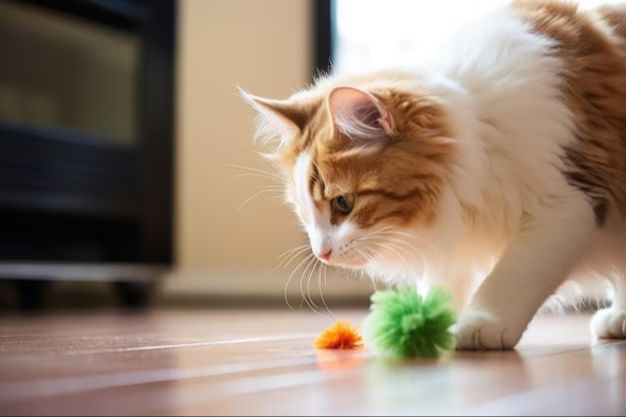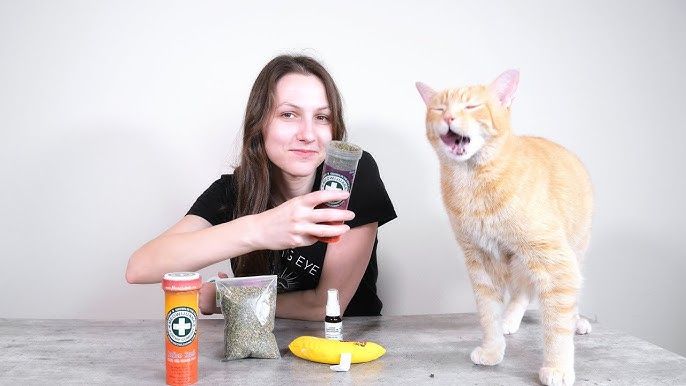What is catnip?
Catnip, also known as catmint, is a perennial herb from the mint family Lamiaceae. Its botanical name is Nepeta cataria. It is characterized by heart-shaped, green leaves with scalloped edges and small lavender flowers that grow in clusters. Native to Europe and parts of Asia, catnip is now naturalized across much of North America.
The catnip plant grows to be 2-3 feet tall and thrives in full sun and well-drained soil. All parts of the catnip plant contain nepetalactone, the essential oil that causes the euphoric effect in cats when they sniff, eat or roll in the plant. Catnip is very aromatic thanks to the volatile oils in the leaves and stems.
Sources:
http://supplementsos.com/herbal-tea/catnip-tea/
Active ingredient in catnip

The active ingredient in catnip that causes the euphoric reaction in cats is called nepetalactone. Nepetalactone is an organic compound that is found in the essential oil of the catnip plant (Nepeta cataria) [1]. This terpenoid compound is extracted from the leaves and stems of the catnip plant and acts as a cat attractant [2]. When cats smell nepetalactone, it binds to receptors in their noses and stimulates a response that affects their behavior and mood.
Effects of catnip on cats
Catnip contains a chemical called nepetalactone that has a powerful effect on most cats when inhaled or ingested (1). Nepetalactone binds to receptors in the cat’s olfactory epithelium, the tissue in the nose responsible for detecting smells. This triggers a response that researchers have described as a temporary euphoric state (2).
The most common behaviors exhibited by cats exposed to catnip include rolling around, rubbing against things, drooling, jumping, and kicking. Cats may meow or growl during this excited state. Other effects can include stretching, flipping over, and head shaking. Typically the catnip reaction lasts around 5-15 minutes before the cat loses interest and goes back to normal (1).
While catnip causes a stimulated, energized response in cats, it does not actually have a hallucinogenic effect like some claim. Cats do not see or experience anything that is not there when exposed to catnip. The euphoric catnip response is instinctual and harmless, though care should be taken not to overexpose cats to large doses of catnip (2).
(1) https://www.petmd.com/cat/general-health/what-is-catnip
(2) https://www.humanesociety.org/resources/crazy-catnip
Why does catnip affect cats this way?

Catnip contains an organic compound called nepetalactone that interacts with receptors in a cat’s nose and induces a response (Scientific American). This compound binds to the feline olfactory receptors and mimics feline “happy” pheromones. When inhaled, nepetalactone is sensed by the olfactory epithelium at the back of the nose, which triggers a neurological response that affects cats’ behavior.
Nepetalactone does not induce the same response in humans or other animals like dogs. The reason it only affects cats is because the shape and structure of nepetalactone is specifically suited to bind to feline olfactory receptors. It essentially overstimulates this sensory pathway in cats, which leads to the characteristic playful and euphoric behaviors. However, nepetalactone does not activate the “reward centers” in a cat’s brain the same way addictive drugs like marijuana do in humans. So catnip is not considered addictive or habit-forming for cats.
Is the catnip reaction safe?
For the most part, catnip is considered harmless for domestic cats when used in moderation. The active chemical in catnip, called nepetalactone, binds to receptors in a cat’s nose and has a stimulating effect (PetMD). This causes a temporary high-like state with effects like rolling around, rubbing, hyperactivity and excited vocalizations.
These reactions to catnip are perfectly normal and not harmful for cats. However, using large amounts of catnip or giving it too frequently can cause overstimulation. Signs of catnip overdose include drooling, vomiting, diarrhea or agitated behavior. Stop giving catnip and consult a vet if these reactions are observed.
Overall, catnip is safe when given occasionally and in moderation. Monitoring your cat’s individual reaction will allow you to determine what amount is optimal.
Does catnip have medical uses?
Catnip has been studied for potential medical applications beyond its effects on felines. According to WebMD, catnip contains chemicals called nepetalactones that can act as insect repellents [1]. Research suggests catnip oil may be as effective as DEET at repelling certain insects like mosquitoes. Some studies also indicate catnip extract may have anti-inflammatory properties and help relieve skin conditions like acne when applied topically [2]. However, most of these applications require further research before catnip can be recommended as a medical treatment. Overall the current evidence for medicinal uses of catnip in humans is limited.

Catnip has also been used in traditional folk medicine as a remedy for headaches, toothaches, colds and cramps. Catnip tea has been consumed to help promote sleep and relieve anxiety. However, there is no clinical evidence supporting these uses for catnip [3]. As with any herbal supplement, consult your doctor before using catnip for any medical purpose.
Catnip compared to marijuana
There are some similarities between catnip and marijuana in terms of chemical makeup and effects, but also important differences.
The primary psychoactive chemical in marijuana is THC, which binds to cannabinoid receptors in the brain and causes a “high” feeling in humans. Catnip contains a chemical called nepetalactone that is structurally similar to THC and binds to some of the same receptors, causing a euphoric reaction in cats. However, nepetalactone does not produce psychoactive effects in humans the way THC does.
Another key difference is that catnip is not addictive for cats and does not appear to have long-term side effects when used occasionally. Marijuana has a higher potential for addiction and abuse. While catnip may make cats playful and energetic for 10-15 minutes, marijuana intoxication in humans can last for hours.
Additionally, the concentration of nepetalactone in catnip is much lower than the concentration of THC typically found in marijuana. This means the intoxicating effects of catnip are much milder for cats compared to the effects of recreational marijuana for humans.
So in summary, while there are some parallels in terms of active chemicals and short-term behavioral effects, catnip does not produce the same psychoactive and addictive responses in cats that marijuana does in humans.
Sources:

https://www.healthline.com/health/smoking-catnip
https://www.labroots.com/trending/cannabis-sciences/14044/catnip-weed-cats
Responsible Use of Catnip
When giving catnip to your cat, it’s important to be responsible and use good judgement on amount and frequency. According to the Humane Society, you should only give your cat catnip about once or twice a week at most. Giving too much catnip or giving it too often can reduce its effect over time.
It’s recommended to start with small amounts of catnip, such as a pinch or two of dried leaves or a teaspoon of fresh leaves. Monitor your cat’s reaction and adjust accordingly. Giving too much at once increases the chance of overstimulation or other adverse effects.
Potential symptoms of catnip overdose include hyperactivity, agitation, vomiting, diarrhea, and lethargy once the catnip wears off. If you notice any concerning symptoms after giving catnip, contact your veterinarian. Moderation and observation are key to using catnip responsibly.
According to Vetwest Veterinary Clinics, signs of catnip use usually last between 5-15 minutes, after which the cat typically loses interest. Let your cat relax before giving more catnip.
Natural alternatives to catnip
While catnip is by far the most popular plant for cats, there are some other natural plants that can produce a fun and safe reaction in cats. These alternatives to catnip are worth trying, especially if your cat doesn’t respond to catnip.
One alternative is silver vine, which comes from the silver vine plant (Actinidia polygama). Silver vine contains compounds like actinidine that can induce a euphoric reaction in cats similar to catnip. Some cats may even prefer silver vine over catnip. According to https://www.petmd.com/cat/general-health/silver-vine-plant-alternative-catnip[1], silver vine is commonly used as a cat stimulant in its native Asia. You can buy silver vine sticks, balls, and toys to play with your cat.
Valerian is another herb that some cats respond to. Valerian root contains valepotriates that can cause excitability. According to https://catoropets.com/blogs/news/4-alternatives-to-catnip[2], valerian typically has a milder effect than catnip. The reaction varies from cat to cat.
Other plants like Tatarian honeysuckle (Lonicera tatarica) and lemon thyme may also induce a response, but the effects are not as consistent as catnip, silver vine, or valerian.
Takeaways
Catnip contains an active chemical called nepetalactone which interacts with cats’ olfactory systems and central nervous systems in a unique way. This causes cats to display behavioral responses like sniffing, licking, chewing, head shaking, and rolling around. The effects typically last 5-15 minutes.
While catnip may appear intoxicating, it is in fact non-addictive and safe for cats to enjoy. The euphoric behavior is an instinctual response and not harmful. Catnip should always be given in moderation as an occasional treat. Responsible cat owners can use catnip as a natural way to provide environmental enrichment.
Overall, catnip produces a temporary harmless high in cats. The behavioral effects are the result of genetic wiring and do not equate to other recreational substances like marijuana. Catnip is not intoxicating in the same way, nor does it produce long-term changes in the brain. When used appropriately, catnip is a safe part of many cats’ lives.
